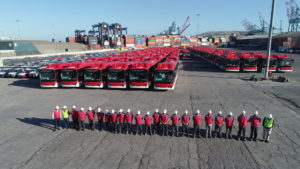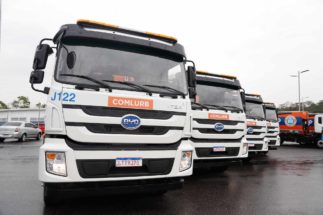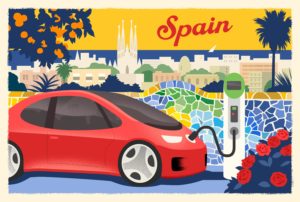Wandering the streets of Chilean capital Santiago, you will notice a swift transition to zero emission transportation is underway. In less than two years, 776 battery-electric buses have arrived. But this is just the start. Nearly 2000 e-buses are already running on Latin American streets today.
Despite such rapid growth, these represent less than 1% of all buses on Latin American roads. Larger purchases are limited by access to new zero emission bus models and to financing the higher upfront cost.
To bridge this gap, the ZEBRA partnership – a collaboration between C40 Cities and the International Council on Clean Transportation (ICCT) – has secured new commitments from over 15 investors and manufacturers to join their efforts to accelerate the deployment of zero emission buses in Latin American cities. The alliance is working to secure up to US$1 billion that would see 3,000 new electric buses deployed on the region’s streets.
These commitments will help meet the demand of public transit authorities and private transport operators in some of Latin America’s biggest cities. Local officials determined to have an entirely zero emission fleet are at the forefront of this wider regional shift.
2035
the year by which Santiago aims to have an entirely zero emissions bus fleet
Santiago is leading the way, with the largest fleet of zero emission buses outside of China and the ambition to achieve a fully zero emission fleet by 2035. Here, offers were recently received for the first of many public tenders, which will lead to the deployment of up to 1,670 battery-electric buses.
Similar innovative tenders are on their way in Bogotá, Colombia, where a purchase of 483 battery-electric buses are getting tuned and are ready to start operations. In Brazil, São Paulo’s recently amended Climate Law requires a gradual transition towards a fleet that is entirely free from fossil emissions by 2038. Sao Paulo hopes to deploy over 3,000 battery-electric buses in the next two years to meet its goal. Medellín, Colombia’s second largest city, and Mexico City have launched significant deployments of zero emission buses and are signatories of the C40 Green and Healthy Streets Declaration, pledging to procure only zero emission buses from 2025 onwards. Rio de Janeiro, which also signed this declaration, has turned the commitment into an official decree.
The pandemic has created a new sense of urgency, challenges and opportunities for the energy transition in the bus fleet, but the benefits are unchanged. Switching from diesel to dedicated electric-drive buses leads to cleaner air and lower greenhouse gas emissions, especially if powered by a low-carbon energy mix, which is often the case in Latin America.
Cleaner air, in turn, has tangible health and economic benefits. This has been emphasised by the greater effects of Covid-19 on people living in cities with poor air quality, for which transport tends to be one of the main culprits, especially in big cities such as Mexico City and São Paulo.
Electric buses are also more energy-efficient, and in the right applications can have a far lower total cost of ownership, offering significant financial savings to those owning and running the buses, as recently disclosed by Metbus, an operator in Santiago.
The availability of zero emission bus models has long been a barrier. China, where 98% of all global electric bus sales occur, is facilitating this transition through the development, upscaling and subsequent cost reduction of key technologies such as batteries and electric drivetrains.
On the one hand, legacy bus manufacturers headquartered in Europe such as Daimler, MAN and Volvo dominate the Latin American bus market with diesel bus technology and see e-buses as a market far in the future. On the other hand, Chinese manufacturers with a far smaller market presence such as BYD, Yutong, and Foton are the largest source of new zero emission bus products in the region.
Higher upfront cost of electric-powered buses (compared to diesel vehicles) and access to finance used to represent some of the biggest hurdles to zero emission bus deployments. To tackle this, public institutions are in a good position to offer financial guarantees to new actors wishing to become key players in new projects.
A quick shift away from diesel buses will play an enormous role in how Latin American countries contribute to halting global warming to 1.5 degrees
The private sector, once averse to risks, is now involved, as shown in Santiago, where utility companies such as Enel X helped develop an innovative business model, which requires the separation of ownership and operation of the buses, and are willing to replicate these cases elsewhere.
New business models like this, along with investors who have more capital and better financial health than public bodies and private transport operators, are instrumental to scale the number of zero emission buses that can be deployed each year. Commitments by new investors to enter the market will be crucial at this time of reduced revenues for all public transport systems across the region.
Regulations and lack of technical requirements adapted to electric vehicles and new business models are also hindering the growth of zero emission bus fleets in Latin America. However, governments are making progress.
Colombia’s Law 1964, which establishes a national electric bus purchase requirement – one of a kind in the region – and Mexico’s recent move to waive import tariffs on all electric vehicles until 2024 represent steps in the right direction. These national actions combined with the local requirements of city officials are the political commitments necessary to re-shape the market environment away from diesel and in favour of zero emission technologies.
Strong collaboration by all the above mentioned players will be needed to meet the growing demand for zero emission buses of Latin America, which relies more than any other region on buses as the principal mode of transport.
A quick shift away from diesel buses will play an enormous role in how Latin American countries contribute to halting global warming to 1.5 degrees by the end of the century, in line with the Paris Agreement. Clean transportation is a crucial element in the decarbonisation of the Latin American economy, a process that could lead to the net creation of 15 million jobs in the region.
The recent commitments of the ZEBRA partnership demonstrate that both technology and capital are available, but stronger policies to halt the procurement of fossil fuel buses remains imperative.
Latin American cities are ready to realise their ambitions for cleaner and healthier streets and provide fertile ground for new investments. Today’s commitments from manufacturers and investors show that a shift in all new bus procurements to zero emission technologies is clearly the way forward and, as of today, unstoppable.








